Related Research Articles

Lebanon, officially known as the Lebanese Republic, is a country in Western Asia. It is bordered by Syria to the north and east and Israel to the south, while Cyprus is west across the Mediterranean Sea. Lebanon's location at the crossroads of the Mediterranean Basin and the Arabian hinterland facilitated its rich history and shaped a cultural identity of religious and ethnic diversity. At just 10,452 km2, it is the smallest recognized sovereign state on the mainland Asian continent.
The foreign policy of Lebanon reflects its geographic location, the composition of its population, and its reliance on commerce and trade. Until 2005, Lebanon's foreign policy had been heavily influenced by Syria. The framework for relations was first codified in May 1991, when Lebanon and Syria signed a treaty of mutual cooperation. This treaty came out of the Taif Agreement, which stipulated that "Lebanon is linked to Syria by distinctive ties deriving strength from kinship, history, and common interests." The Lebanese-Syria treaty calls for "coordination and cooperation between the two countries" that would serve the "interests of the two countries within the framework of sovereignty and independence of each." Numerous agreements on political, economic, security, and judicial affairs have followed over the years.
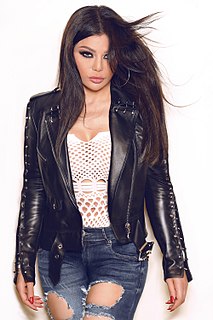
Haifa Wehbe is a Lebanese singer and actress. She has released seven studio albums, and made her acting debut in the 2008 Pepsi-produced film Sea of Stars. In 2006, Wehbe was on People Magazine's 50 most beautiful people list.
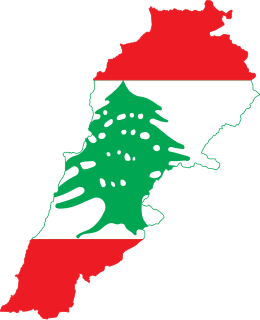
The culture of Lebanon and the Lebanese people emerged from various civilizations over thousands of years. It was home to the Phoenicians and was subsequently conquered and occupied by the Assyrians, the Greeks, the Romans, the Persians, the Arabs, the Crusaders, the Ottoman Turks and the French. This variety is reflected in Lebanon's diverse population, composed of different religious groups, and features in the country's festivals, musical styles, literature, cuisine of Lebanon and architecture of Lebanon. Tourism in Lebanon is popular with periods of interruption during conflict.

Saad El-Din Rafik Al-Hariri is a Lebanese politician who was the Prime Minister of Lebanon from 18 December 2016 to 21 January 2020. He was also the Prime Minister from 9 November 2009 to 13 June 2011. He is the second son of former Lebanese Prime Minister Rafic Hariri, who was assassinated in 2005. Hariri has also been the leader of the Future Movement party since 2005. He is seen as "the strongest figurehead" of the March 14 Alliance. After three years living overseas, he returned to Lebanon on 8 August 2014 and was designated Prime Minister on 3 November 2016. Hariri's surprise announcement of an intent to resign, broadcast on 4 November 2017 on Saudi state TV, has widely been seen as part of the Iran–Saudi Arabia proxy conflict in Lebanon, and triggered a dispute between Lebanon and Saudi Arabia. The resignation was later suspended, following President Michel Aoun's request to "put it on hold ahead of further consultations". On October 29, 2019, amid the 2019–20 Lebanese protests, Hariri announced his resignation, and that of his cabinet.

An-Nahar is a leading Arabic-language daily newspaper published in Lebanon.

The Daily Star is a pan–Middle East newspaper in English that is edited in Beirut, Lebanon but deals with the whole Middle East.
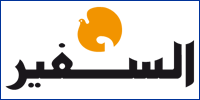
As-Safir, meaning The Ambassador, was a leading Arabic-language daily newspaper in Lebanon. The headquarters of the daily is in Beirut. It has been in circulation from March 1974 until December 2016. The last issue of the paper was published on 31 December 2016. The online version was also closed on the same date.
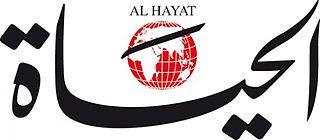
Al-Hayat is a London-based, pan-Arab newspaper owned by Saudi Prince Khalid bin Sultan, with a circulation estimated over 200,000. It is the newspaper of record for the Arab diaspora and the preferred venue for liberal intellectuals who wish to express themselves to a large public.

The Israeli–Lebanese conflict, or the South Lebanon conflict, refers to a series of military clashes involving Israel, Lebanon and Syria, the Palestine Liberation Organization, as well as various militias acting from within Lebanon.
Al-Ittihad is an Arabic language newspaper published daily in the United Arab Emirates. The paper is the first regular publication of the country.
Television in Lebanon arose as a private initiative and not a state-institution. Lebanon was the first country in the Middle East & the Arab world to have indigenous television broadcasting. Various Arab televisions emulated the Lebanese model.

Al Riyadh is a Riyadh-based, pro-government Saudi daily newspaper. Its sister paper was Riyadh Daily that was disestablished on 1 January 2004. Al Riyadh is one of the dominant papers in Nejd.

Al Eqtisadiah is a Saudi daily newspaper, published by Saudi Research and Publishing Company. It is published in Arabic.

Al Mayadeen is a pan-Arabist satellite television channel launched on 11 June 2012 in Beirut, Lebanon. Its programming is predominantly news. It has news reporters in most Arab countries. In the pan-Arab TV news market it competes against Al Jazeera and Al Arabiya, and also against Sky News Arabia and BBC Arabic Television. At its founding in 2012, many of Al Mayadeen's senior staff were formerly correspondents and editors at Al Jazeera. Al Mayadeen is viewed as pro-Hezbollah and pro-Syrian government.

Ghassan bin Jiddo, is a veteran Tunisian-Lebanese journalist, activist and the director of Beirut-based pan-Arab satellite television channel, Al Mayadeen. He has been recognized in the popular press as an influential Arab personality.
Lisan al-Hal or Lissan ul-Hal was a Lebanese Arabic language daily newspaper established by Khalil Sarkis in 1877 and is the oldest Lebanese publication still published in Lebanon.
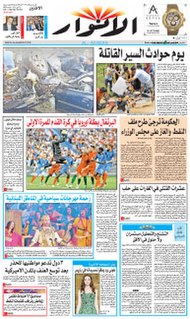
Al Anwar was an Arabic daily newspaper published in Lebanon. It was founded in 1959 and was one of the leading dailies in Lebanon. In October 2018, the publisher Dar Assayad announced ceasing of the print edition of the publication after 58 years of continuous publishing. Dar Assayad also ceased the publication of its line of long-running periodicals such as its newsweekly magazine Assayad, its arts and entertainment weekly Achabaka, its women monthly Fayrouz, men monthly Al Fares and defense military monthly Al Difa' Al Arabi amongst others.
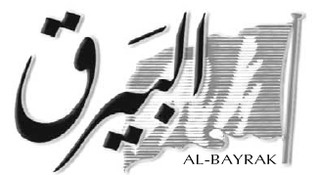
Al Bayrak was an Arabic newspaper published in Lebanon and was headquartered in Beirut. It was one of the leading and oldest Arabic papers in the country. After being published for a century the paper closed in 2011.
Al Liwaa is an Arabic daily newspaper published in Lebanon and headquartered in Beirut. It is one of the leading Arabic dailies in the country. In addition, it is one of the oldest publications in Lebanon.
References
- ↑ Migliorino, p. 122
- 1 2 3 "Lebanon profile. Media". BBC. 29 January 2013. Retrieved 9 September 2013.
- 1 2 Dale F. Eickelman; Jon W. Anderson (1 July 2003). New media in the Muslim world: the emerging public sphere . Indiana University Press. pp. 63–65. ISBN 978-0-253-34252-2 . Retrieved 11 December 2011.
- 1 2 "Media sustainability index 2008" (PDF). IREX. Archived from the original (PDF) on 12 July 2013. Retrieved 15 September 2013.
- 1 2 Yahya R. Kamalipour; Hamid Mowlana (1994). Mass Media in the Middle East: A Comprehensive Handbook. Westport, CT: Greenwood Press. Retrieved 9 September 2013. – via Questia (subscription required)
- ↑ Arabic and the Art of Printing: A Special Section. Saudi Aramco World. Retrieved on 11 December 2011.
- ↑ The First Arabic Script Printing Press in Lebanon: Arabic Type Designer & Typographer: Arabic Type: Pascal Zoghbi. 29letters 5 January 2009. Retrieved 11 December 2011.
- ↑ Lebanon A Country Study by Federal Research Division, p. 42
- 1 2 Andrew Hammond (2005). Pop culture Arab world!: media, arts, and lifestyle. ABC-CLIO. p. 94. ISBN 978-1-85109-449-3 . Retrieved 11 December 2011.
- 1 2 3 4 Migliorino, p. 123
- ↑ Migliorino, p. 124
- 1 2 Dajani, Nabil (Summer 2013). "The Myth of Media Freedom in Lebanon" (PDF). Arab Media and Society (18). Archived from the original (PDF) on 27 September 2013. Retrieved 22 September 2013.
- ↑ Anker, Jean. Libri: Volume 51
- ↑ "Francophone book fair showcases Lebanese and foreign authors". The Daily Star. 28 October 2011. Retrieved 4 November 2011.
- ↑ Zahera Harb (30 May 2010). Channels of Resistance in Lebanon: Liberation Propaganda, Hezbollah and the Media. I.B.Tauris. p. 97. ISBN 978-1-84885-120-7 . Retrieved 11 December 2011.
- ↑ Karam, Zeina (11 June 2012). "New pan-Arab satellite channel goes on air". AJC News. Associate Press. Retrieved 11 June 2012.
- ↑ Sami Atallah (June 2013). "Turning a research idea into a national movement" (PDF). National Endowment for Democracy. Archived from the original (PDF) on 28 October 2013. Retrieved 15 September 2013.
- ↑ "Middle East Media Use Report 2016" (PDF). Qatar Northwestern University Publications.
- ↑ "Social Media · Media Use in the Middle East, 2017". www.mideastmedia.org. Retrieved 2018-08-20.
- ↑ Kowalczyk, Kasia (2017-08-12). "Facebook and Instagram user demographics in Lebanon – August 2017". NapoleonCat. Retrieved 2018-08-20.
- ↑ "المصوراللبناني المبدع / سعيد محمد Said Mhamad Photography – من أشهر المصورين المحترفين للأعراس على مستوى مواقع التواصل الإجتماعي على الفيس بوك -صوره أقرب للاحلام من الواقع ..لكنها واقع حي ..- حوار : كاتيا بواب .. | مجلة فن التصوير". www.fotoartbook.com (in Arabic). Retrieved 2018-08-20.
- ↑ "Our list of top 20 Arab social media stars". StepFeed. 2017-06-30. Retrieved 2018-08-20.